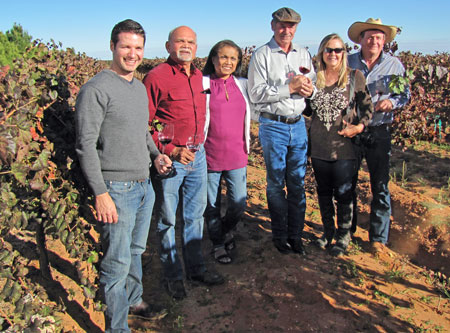
Texas Wine’s High Plains A-Team: Newsom, Reddy, Llano Estacado
As I disembarked from the plane in Lubbock, I recall thinking that the skies above the Texas high plains are bigger and bluer than just about anywhere I’ve been on this good Earth. The air had the familiar dry bite of the area’s fine red sands, and if I took a deep enough breath, I could also sense the underlying desiccant of the porous caliche limestone. After this brief reflection, I started my way to Brownfield, about an hour south of Lubbock. It’s in Terry County, the acknowledged wine grape growing capital of Texas.
At my destination, Reddy Vineyards, was the point of rendezvous for the wine writer meet-up with the rightfully named “Texas High Plains A-Team”. The A-Team consisted of winegrowers Vijay and Subada Reddy (Reddy Vineyards) and Neal and Janice Newsom (Newsom Vineyards), and winemakers Greg Bruni and Jason Centanni and CEO Mark Hyman (Llano Estacado Winery). The grape growing and wine making/selling experience packed into this assemblage spans the last 30 years with some of the best Texas wines on record being credited to their collective hard work and dedication.
Lunch was served with a selection of Llano Estacado Winery wines as we looked out from Vijay’s second story office into his vineyard. The vines were “all-Reddy” easing their way into their winter slumber period, contrasting themselves against the bright, red-orange vineyard soil. This soil (red sandy loam over pour caliche limestone, something that covers much of the Texas High Plains region) has already obtained notoriety for its low-vigor way of making grapevines focus on making fine, high quality wine grapes.
Presented were two of Llano Estacado Winery’s unoaked wines:
2014 Pinot Grigio (67% Reddy Vineyards and 33% Newsom Vineyards) and 2014 Cinsault Rosé (100% Reddy Vineyards), both with Texas High Plains appellation. The third wine was Llano Estacado THP Stampede (oaked red blend) made with 56% Petite Verdot, 29% Petit Sirah, and 13% Syrah (all Reddy Vineyards), and 2% Cabernet Sauvignon (Newsom Vineyards).
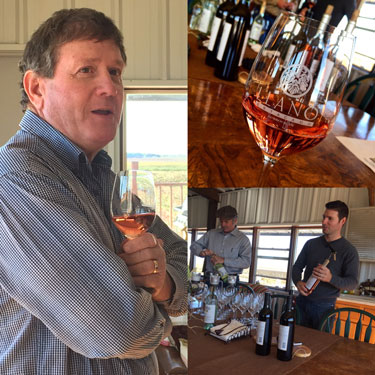
This presentation was very appropriate since the High Plains region was where the words “Texas wine” in its modern sense were likely first spoken. Texas wine, also in its modern sense, was first made and tasted in the basement lab in the Texas Tech Chemistry building in Lubbock. Much of the credit for these events has been given to Clinton “Doc” McPherson, the college chemistry professor that took the plunge into Texas wine research and later helped to start the first and longest running of Texas’s modern wineries, Llano Estacado Winery (federally bonded in 1977), the winery that now hosted our high plains visit.
As you might imagine, Neal and Janice’s Newsom Vineyards about an hour to the west in Plains is no upstart in the Texas wine industry either. They have grown and harvested some of the state’s most sought after wine grapes for the past 30 years. Neal convinced his father to become a winegrower in 1986 and planted three acres of grapes while still growing cotton as the family’s primary crop. Newsom Vineyards now includes over 100 acres of wine grapes and Neal and Janice’s cotton land is leased to others to row-crop.
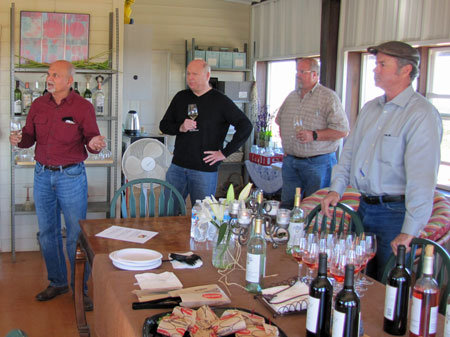
Reddy Vineyards now amasses over 200 acres of wine grapes, including 25 grape varieties, since starting his Texas vineyard in 1997 after obtaining a degree in soil science in the U.S. and gaining experience growing cotton and peanuts on the High Plains. Prior to that, he was a highly experienced farmer of produce and grain in South India.
Later in the afternoon, we caravanned to Llano Estacado Winery to see their new and expanded tasting room and newly constructed events center. Once there, we toured and tasted.
Our tasting included a selection of five wines made at Llano Estacado Winery coming from the 2013 and 2014 vintages and originating primarily from Mont Sec Vineyards (Del City in far west Texas), Newsom Vineyards and Reddy Vineyards:
Two non-oaked wines – 2014 Mont Sec Sauvignon Blanc (95% Sauvignon Blanc & 5% Chardonnay both from Mont Sec Vineyard) and 2014 Mont Sec Viognier (100% Viognier from Mont Sec Vineyard)
Three oaked wines – 2014 Harvest Texas Tempranilo (100% Tempranillo from Newsom, Reddy, Linker and Paso Robles vineyards, 2013 Due Compaensani (Red blend – 57% Sangiovese and 43% Montepulciano – 100% Reddy Vineyards) and 2013 Montepulciano (85% Montepulciano, 12% Aglianico and 3% Barbara – 100% Reddy Vineyards.
What we received that day was a firsthand update on the new directions in Texas wine emanating from Llano Estacado Winery including what Greg Bruni called his winemaking team’s take on “post-modern” winemaking. This includes the use of various aging regimes including new French and American oak, neutral oak (3 years or older barrels) or micro-oxygenation and alternative oak additions to systematically produce fine wines that meet their expectations for quality while residing within their intended price point in the marketplace. One thing I’ve learn in 20 years of wine writing is, this is not a trivial task.
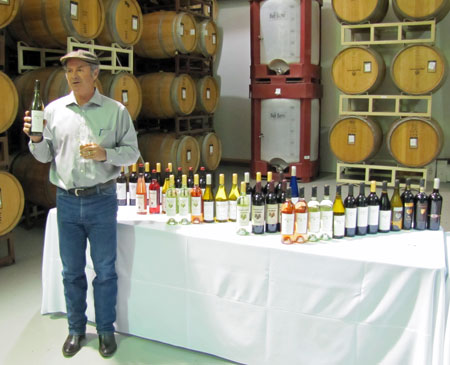
Equally impressive was Llano Estacado’s new marketing plan that included segmenting its conventional offerings and their new lines of premium wines for on-premise (restaurant), tasting room and private label sales. The best news was the major emphasis on this new market wines was going to be on making them Texas appellation; meaning they would be made with at least 75% Texas fruit going into the bottle as mandated by federal regulations. More Texas wine from the well distributed Llano Estacado Winery should lead to more smiles on the faces of Texas wine consumers.
Later, we sat down to dinner in the new events center at Llano Estacado Winery where we got to tasting many of the fine wines from Llano Estacado and McPherson Cellars. Only one wine (Llano Estacado Chardonnay) would have been recognizable 15 years ago. All other were modern blends of white or red grapes or were made from grape varieties like Viognier and Albariño that were literally unheard of by most consumers back in those days, but that have now made a strong showing in the Texas wine marketplace.
If awards for perseverance and dedication were going to be given out that evening, They would go to both the Newsoms and Llano Estacado. In 2013, the springtime weather was not kind to high plains grape growers. It it threw at them something like six springtime freezes during the period of late-April through early-May – somethine unheard in record history in Texas. As a result, when harvest time came, all Neal had to show for it was less than one bin of harvested grapes, mostly reds, from their 100-plus acre vineyard. In this bin, there was perhaps only enough grapes to make a barrel or two of wine.
One day, Neal took this partially filled bin of grapes to Llano Estacado. He asked Mark Hyman if Llano Estacado would just take the grapes hardly expecting any form of remuneration.
After mulling it over, Mark Hyman at Llano Estacado made a decision with Greg Bruni’s help. It was a show of dedication to someone who was both a personal friend and a high plains grower with a long pedigree. The Llano Estacado Duo offered to take the Newsom grapes. In return, they pledged to make Janice and Neal their first private labeled wine. About mid-way through our evening dinner, this wine was poured – 2013 Newsom Family Vineyards, Inception Red, a blend of all the grapes Neal had in his half-filled bin. I know that we savored that taste of Texas more than any wine presented the whole day. It was a testament to the perseverance of all Texas winemakers and showed that miracles can come from a partial bin of grapes!
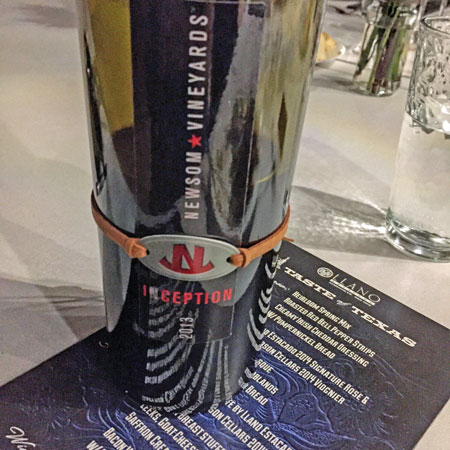

The A team! Simply the best!!!